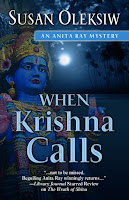 I’ve posted before about the end of the Five Star Mystery
Line, but it seems there’s more to say. When something comes to an end, I tend
to say, “Okay, I’m done with that,” and move on. I often think I’ll have
trouble letting go, but in the end I don’t. It’s something in my DNA. And yet I
do have trouble thinking I’ll never write or publish another novel featuring
Anita Ray. But that’s not the lingering question.
I’ve posted before about the end of the Five Star Mystery
Line, but it seems there’s more to say. When something comes to an end, I tend
to say, “Okay, I’m done with that,” and move on. I often think I’ll have
trouble letting go, but in the end I don’t. It’s something in my DNA. And yet I
do have trouble thinking I’ll never write or publish another novel featuring
Anita Ray. But that’s not the lingering question.
When I began writing the Anita Ray stories, I created a
character who emerged in part in relation to her scatty Auntie Meena and the
other denizens of Hotel Delite. The stories were about the world of this hotel
as well as the main characters. Anita and her Auntie remained static in the
sense that they didn’t really age. In each book, Anita might be a month older,
or even younger. It didn’t matter. The only concrete comment about her age was
that she was closer to thirty than twenty and she was still unmarried.
Unmarried! At her age. A scandal. And a gnawing shame for Auntie Meena. That
was the premise at the beginning. But now?
With the prospect of working on a series set adrift from any
official publisher, I seem to find specific aspects of the set-up also
drifting. I could continue the series by heading in a different direction.
Anita could marry and move into the hillside. I fell in love with Munnar and
tea plantations on an earlier visit, and I can easily imagine Anita living
there. Or, she could return to the United States to visit her parents. (This is
the opportunity that least appeals to me, but I mention it to be complete.) Or
perhaps she opens a gallery in Trivandrum and lives there, away from Hotel
Delite. But I’d miss Auntie Meena and Ravi and Moonu and all the others.
I’m thinking about this now because today I had lunch with
four other women and we talked aboutIndia and our travels. One woman had lived
in Brazil, Indonesia, Pakistan, parts of Africa, as well as the US. One grew up
in Northern India. The lunch was special for another reason. One cooked an
amazingly delicious lunch of Indian dishes, another brought copies of CDs of
her son’s music (he plays the sitar), the hostess shared her home and a couple
of books, another brought a book on knitting and a dessert of fresh fruit, and
I brought the four Anita Ray books to give away.
I love writing the Anita Ray books, and I love exploring
ideas for them even more. As I type this I can feel possible scenarios
developing. I enjoy having her four novels out there in the world, and a few
more short stories scheduled to appear soon. For now that will have to be
enough. But I know I’ll figure out something and Anita Ray will continue to
have adventures and solve crimes.
To find the Anita Ray mysteries, go here.








